PIAS1 and TIF1γ collaborate to promote SnoN SUMOylation and suppression of epithelial-mesenchymal transition
- PMID: 32770107
- PMCID: PMC7853041
- DOI: 10.1038/s41418-020-0599-8
PIAS1 and TIF1γ collaborate to promote SnoN SUMOylation and suppression of epithelial-mesenchymal transition
Erratum in
-
Correction: PIAS1 and TIF1γ collaborate to promote SnoN SUMOylation and suppression of epithelial-mesenchymal transition.Cell Death Differ. 2021 May;28(5):1753. doi: 10.1038/s41418-020-00611-z. Cell Death Differ. 2021. PMID: 32811972 Free PMC article. No abstract available.
Abstract
SUMO E3 ligases specify protein substrates for SUMOylation. The SUMO E3 ligases PIAS1 and TIF1γ target the transcriptional regulator SnoN for SUMOylation leading to suppression of epithelial-mesenchymal transition (EMT). Whether and how TIF1γ and PIAS1 might coordinate SnoN SUMOylation and regulation of EMT remained unknown. Here, we reveal that SnoN associates simultaneously with both TIF1γ and PIAS1, leading to a trimeric protein complex. Hence, PIAS1 and TIF1γ collaborate to promote the SUMOylation of SnoN. Importantly, loss of function studies of PIAS1 and TIF1γ suggest that these E3 ligases act in an interdependent manner to suppress EMT of breast cell-derived tissue organoids. Collectively, our findings unveil a novel mechanism by which SUMO E3 ligases coordinate substrate SUMOylation with biological implications.
Conflict of interest statement
ASC is currently employed at Fog Pharma, USA. However, this study is neither funded nor associated in any manner with Fog Pharma. The other authors declare no conflict of interest.
Figures

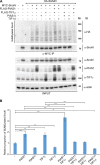


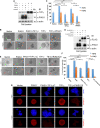
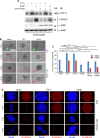
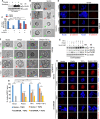
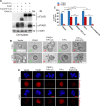
Similar articles
-
TIF1γ protein regulates epithelial-mesenchymal transition by operating as a small ubiquitin-like modifier (SUMO) E3 ligase for the transcriptional regulator SnoN1.J Biol Chem. 2014 Sep 5;289(36):25067-78. doi: 10.1074/jbc.M114.575878. Epub 2014 Jul 24. J Biol Chem. 2014. PMID: 25059663 Free PMC article.
-
Suppression of TGFβ-induced epithelial-mesenchymal transition like phenotype by a PIAS1 regulated sumoylation pathway in NMuMG epithelial cells.PLoS One. 2010 Nov 12;5(11):e13971. doi: 10.1371/journal.pone.0013971. PLoS One. 2010. PMID: 21103059 Free PMC article.
-
Sumoylated SnoN represses transcription in a promoter-specific manner.J Biol Chem. 2006 Nov 3;281(44):33008-18. doi: 10.1074/jbc.M604380200. Epub 2006 Sep 11. J Biol Chem. 2006. PMID: 16966324
-
Regulation of the sumoylation system in gene expression.Curr Opin Cell Biol. 2008 Jun;20(3):288-93. doi: 10.1016/j.ceb.2008.03.014. Epub 2008 May 28. Curr Opin Cell Biol. 2008. PMID: 18468876 Free PMC article. Review.
-
SnoN signaling in proliferating cells and postmitotic neurons.FEBS Lett. 2012 Jul 4;586(14):1977-83. doi: 10.1016/j.febslet.2012.02.048. Epub 2012 Mar 8. FEBS Lett. 2012. PMID: 22710173 Free PMC article. Review.
Cited by
-
SUMOylation of Rho-associated protein kinase 2 induces goblet cell metaplasia in allergic airways.Nat Commun. 2023 Jul 1;14(1):3887. doi: 10.1038/s41467-023-39600-4. Nat Commun. 2023. PMID: 37393345 Free PMC article.
-
The Role of SUMO E3 Ligases in Signaling Pathway of Cancer Cells.Int J Mol Sci. 2022 Mar 26;23(7):3639. doi: 10.3390/ijms23073639. Int J Mol Sci. 2022. PMID: 35408996 Free PMC article. Review.
-
Therapeutic Potential of Targeting the SUMO Pathway in Cancer.Cancers (Basel). 2021 Aug 31;13(17):4402. doi: 10.3390/cancers13174402. Cancers (Basel). 2021. PMID: 34503213 Free PMC article. Review.
-
SUMOylation Wrestles With the Occurrence and Development of Breast Cancer.Front Oncol. 2021 Apr 21;11:659661. doi: 10.3389/fonc.2021.659661. eCollection 2021. Front Oncol. 2021. PMID: 33968766 Free PMC article. Review.
-
PIAS family in cancer: from basic mechanisms to clinical applications.Front Oncol. 2024 Mar 25;14:1376633. doi: 10.3389/fonc.2024.1376633. eCollection 2024. Front Oncol. 2024. PMID: 38590645 Free PMC article. Review.
References
Publication types
MeSH terms
Substances
Grants and funding
LinkOut - more resources
Full Text Sources

